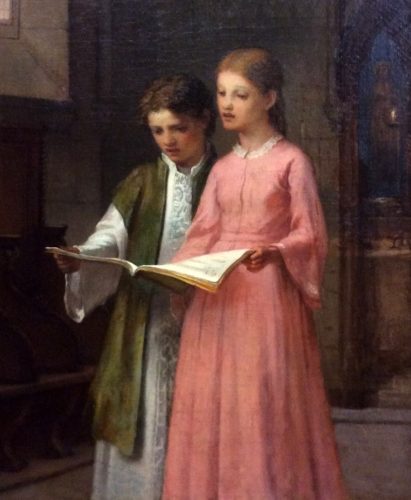
William Morris Hunt
American, 1824-1879
The Singers, 1859
oil on canvas
24 × 20 × 1 in.
SBMA, Bequest of Hugh E. and Marjorie S. Petersen
2017.4

Self-portrait, n.d.
"Strive for simplicity! Don't have the face a checkerboard of tints! Use such colors as nature uses, but not try to keep them distinct! Your work may be called monotonous, but one tone is better than many which do not harmonize." - William Morris Hunt
COMMENTS
ACQUISITION PROPOSAL - GIFT, Santa Barbara Museum of Art, March 6, 2017
Though not well remembered today, William M. Hunt was considered one of the most influential artists of the Boston School in the 1850s and 60s. His parents were both from distinguished families. Upon the premature death of his clergyman father, William and his brother, Richard (who would go on to become an architect), profited from their mother’s youthful, stifled ambition to learn how to paint—she insisted on taking the family to Switzerland, Rome, the South of France, and finally, to Paris, where William became an aspiring art student in the studio of the celebrated history painter, Thomas Couture (1815-1879). When Hunt returned to America, after 11 years in Europe in 1855, he met and married Louisa Dumaresq Perkins, whose prominent family provided him with instant access to the elite of Boston society.
Hunt is perhaps best remembered today as one of the earliest American champions of the art of Jean-François Millet and the Barbizon school, and of the Impressionists. He established influential art schools in Newport, Rhode Island, Brattleboro, Vermont (where he was born), Faial Island in the Azores, and in Boston. The lively society that Hunt kept included such cultural luminaries as Ralph Waldo Emerson, Henry Wadsworth Longfellow, and Erastus Brigham Bigelow (a founder of the Massachusetts Institute of Technology). Tragically, the five large canvases by Millet that Hunt had brought to America burnt up in the Great Boston Fire of 1872, along with many of the artist’s own works. Nevertheless, Hunt’s own art stood as an influential vehicle by which the ideals of aesthetic honesty and sincerity were widely disseminated among some of the most advanced American artists, especially for younger artists such as Winslow Homer, Thomas Eakins, and Childe Hassam.
While Hunt pursued various subjects, including landscape as exemplified by the Barbizon artists he so admired, the greater demand for portraiture in Boston society set the course of his production.
Our painting is a fine example of the kind of genre subject that Hunt also found to be highly marketable, along the lines of the similarly themed paintings developed by his teacher, Couture.
It may have been produced with the idea of having it disseminated through reproductive engravings and we know that it had a pendant called The Listeners (currently offered by Vose Gallery, Boston, of the same dimensions, and also dated to 1859). The pair of paintings were exhibited together as such at the National Academy of Design in 1865, as noted by a New York Times art critic. It is possible that Hunt made two sets of the pendant pair, as there appears to be another version of The Singers in the collection of the Gibson House Museum in Boston. (I am still waiting for confirmation of this.)
We also know, through his student, Helen Knowlton’s 1899 account, that these two pictures were offered by the artist for sale in “the Studio Building,” for $300 (Knowlton,1899, p. 152).
One of Hunt’s last and most ambitious projects was a commissioned pair of large-scale murals for the Assembly Chamber of the State House in Albany, New York.
These large-scale decorations, while well-received, did not result in any further commissions to decorate the rest of the chamber, which may have been one of the root causes for the artist’s subsequent depression. While suicide has been vigorously denied by the artist’s family, Hunt was discovered drowned in a small pond on the Isle of Shoals, where he was staying as the guest of some old friends. He was 55 years of age.
Eik Kahng, PhD
Assistant Director & Chief Curator
10 March 2017
